Explanation of Slicers and their Functionality
A Slicer is a quicker, easier, and more intuitive way to filter data.
In the above example, all you need to do is create Slicers for month, product, and country, and select the relevant values for each of these fields with just 3 clicks. And voila! You have the numbers your boss asked for within seconds!
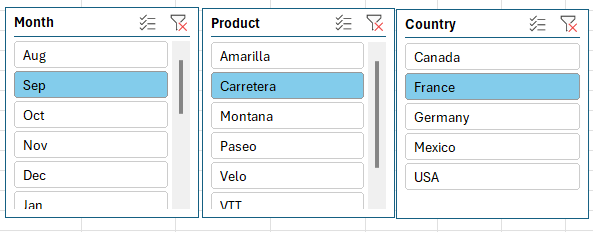

But wait, the magic doesn't just end there, once your boss is done seeing the numbers, you just need to click the clear filters button in the top right of each Slicer to revert your data back to its original state. Or check the clear filters button on the Data tab of the ribbon to remove them all in one go:

Slicers Can Enhance Analysis
Suppose your data has 2 more columns - Segment and Profit, and you need to figure out which segments are making losses while which are profitable.
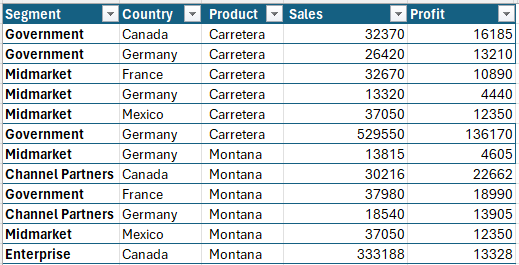
You can build PivotTables and charts, or filter the profit column for only negative values, OR use Slicers!
Start by creating 2 Slicers for Segment and Profit.
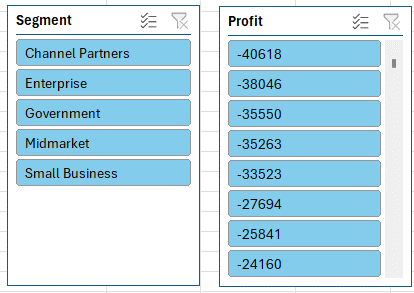
Note: Slicers automatically sort in numerically/alphabetically, which is negative to positive in the case of the Profit Slicer.
Now select
any one Segment, such as Channel Partners, and simply look as the first Slicer value in the profit Slicer. Segment Slicer filters your data and all the other Slicers too. Therefore, you will only see those values in your Profit Slicer belonging to the selected Segment.
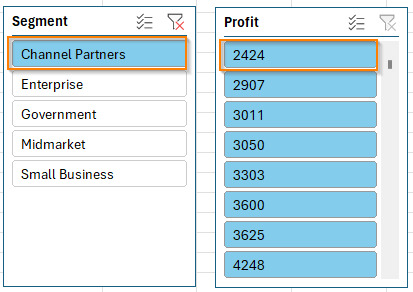
We can see above the first value in the Profit Slicer is positive, the Channel Partner segment is not making any losses.
Click on each Segment one by one to find out which Segment is making losses in just a few clicks.
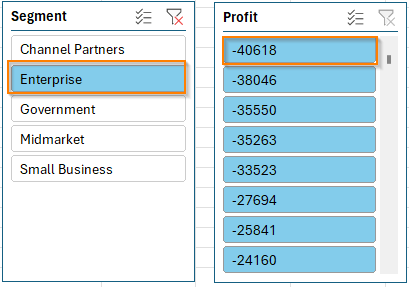
Knowing that the Enterprise segment is the loss-making segment, you can investigate further and take necessary action.
Creating and Customizing Slicers
Before adding a Slicer, make sure your data is in a Table format and preferably without any empty cells in the columns you want Slicers for.
Use any one of the following methods to insert a Slicer.
Method 1: Add a Slicer from the Insert Tab
Click on any cell
within your Table > Go to Insert Tab > Select Slicer:
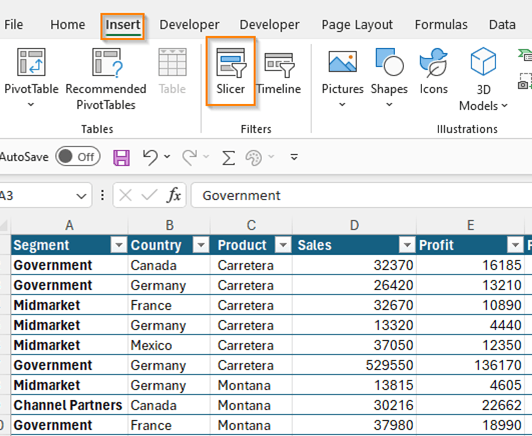
An Insert Slicer window will appear, choose the field (column) you want to filter your data on. You can select multiple fields. Each field will have a Slicer of its own:
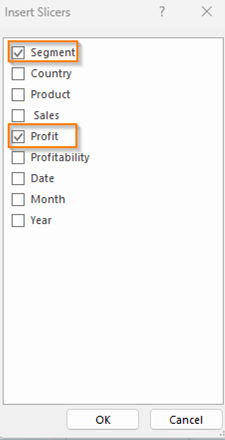
Method 2: Add a Slicer from the Table Design Tab
- Click on any cell within your Table > Go to Table Design Tab > Select Insert
Slicer:

The Insert Slicer window will appear, for you to choose a field.
Customization Options for Slicers
Slicers have many formatting options available via the Slicer tab:

However, they are a bit chunky and take up a lot of space. Unfortunately, many of the most important formatting options are buried. Check out this tutorial on Slicer Formatting for insider secrets on making Slicers really small and more.
How Slicers Interact with Tables
Slicers have several components to
help you filter data efficiently:
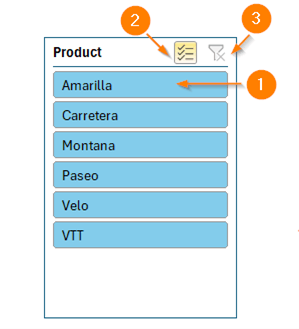
- Selection buttons:
Select the desired items by clicking on them. To select multiple items, keep CTRL pressed while selecting them or hold SHIFT to select a range of items.
- Multi-select button: To select multiple items without pressing CTRL, click on the multi-select button on use the shortcut Alt +S. This is handy when working with touch screen devices and can't easy hold CTRL or SHIFT to
multi-select.
- Clear filters: Press to undo selection i.e., revert your data to the original state
If you have a lot of items, Slicers will automatically have a scroll bar.
Multiple Slicers Interaction
As hinted in the Segment-Profit example, Slicers filter other Slicers. This property makes filters applied by Slicers
additive.
When you select one Segment, the Profit Slicer's scope is automatically reduced. Instead of showing all Profit values, it only shows the Profit values of the selected segment. Data with no values in the current filter state becomes lightly shaded compared to relevant data.
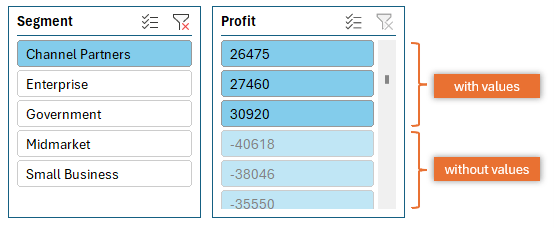
Advanced Techniques
A handy alternative to summarising your data with a PivotTable is to use aggregation functions that ignore filtered rows, like SUBTOTAL and AGGREGATE, to summarise data in response to Slicer selections.
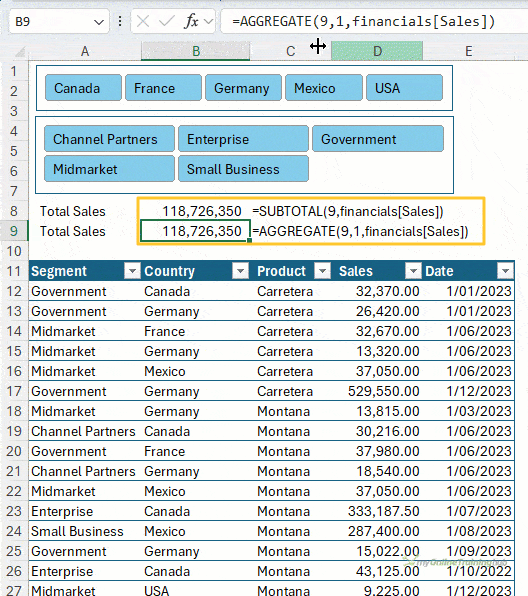
Thanks to Jon von der Heyden for this tip.
Tips and Best
Practices
- Consider the order of Slicers on the sheet: Put them in a logical order that leads the user on a journey through the data. e.g. if users are interested in only one region, then put the Region Slicer first.
- Slicer placement: Slicers work independently of the sheet
where the Table is stored. Thus, you can simply cut and paste them to a report sheet along with your other visuals.
- Slicers snap to grid: Press Alt while moving multiple Slicers so that they snap to grid while moving them.
- Keep Slicers aligned: Press SHIFT while moving the
Slicer vertically or horizontally so that it stays aligned to the starting location on the worksheet.
Limitations of Slicers
- Slicers only connect to one Excel table: You can have multiple Slicers for an Excel table, but you can't use the same Slicer to connect to multiple Excel tables. To
use Slicers to filter multiple tables, use multiple Pivot tables instead. Check out this tutorial for more on PivotTables.
- No 'Select All' button: Slicers
don't have a 'Select All' button. Although there is a clear filter button that has the same effect. Just note that if you want to remove the Slicer headers to make it look more appealing, you'll have to manually select all values to clear filters.
- Slicers take up quite a lot of space: If left in their default style, Slicers take up a lot of space. Follow the tips in this tutorial on Slicer Formatting mentioned earlier for insider secrets on making Slicers really small and more.
- Multiple Slicers are needed to filter multiple fields: If
you have grouped dates in your data in mm-dd-yyyy format, you might need 2 Slicers to filter your data for months and years. To avoid having too many Slicers, create helper columns concatenating 2 or more fields, check out this tutorial on Helper Columns.
Next Steps
Tables can significantly improve efficiency but less than 2% of Excel users know how to use them! Make sure you're getting
the most out of Excel with our Excel Tables course.
Or are you ready for PivotTables?
PivotTables can seem overwhelming at first, but in our 1.5 hour PivotTable Quick Start course we'll have you up and running and wondering what all the fuss was about as they enable you to rapidly build interactive reports. Spoiler: it's all in getting the data
layout right.
Get the insider tips on how to format Slicers in our comprehensive Slicer Formatting tutorial.